
Nikon D800 Instruction Manual: A Comprehensive Guide
Welcome to the comprehensive guide for the Nikon D800 DSLR camera! This manual is designed to help you master your camera, understand the basics, and explore advanced functions․ Find detailed instructions, tips, and solutions to common issues․
The Nikon D800 is a professional-grade DSLR camera renowned for its exceptional image quality and versatility․ It features a full-frame sensor delivering outstanding resolution, making it ideal for landscape, portrait, and studio photography․ This camera provides a wide dynamic range and excellent low-light performance, ensuring stunning results in various shooting conditions․
Designed for both enthusiasts and professionals, the D800 offers an array of advanced features, including customizable settings, multiple shooting modes, and robust build quality․ The camera’s ergonomic design ensures comfortable handling and ease of use, even during extended shooting sessions․ The comprehensive menu system allows for precise control over every aspect of the image capture process․
Whether you’re a seasoned photographer or just starting out, the Nikon D800 provides the tools and capabilities to elevate your photography to the next level․ This guide aims to provide you with a thorough understanding of the camera’s features, functions, and settings, enabling you to unlock its full potential․ Dive in and discover the world of possibilities that the Nikon D800 offers․
Downloading the Nikon D800 User Manual (PDF)
Accessing the Nikon D800 user manual in PDF format is a straightforward process, ensuring you have a comprehensive guide at your fingertips․ The PDF manual provides detailed information on every aspect of the camera, from basic operation to advanced features․ You can easily download it from the official Nikon website or through various online resources that host camera manuals․
To download the manual from Nikon’s website, navigate to the support section and search for the D800 model․ Look for the “Manuals” or “Downloads” tab, where you’ll find the PDF version available for download․ Ensure you have a PDF reader installed on your device to open and view the document․
Having a digital copy of the manual allows you to quickly search for specific topics, zoom in on diagrams, and access the information on your computer, tablet, or smartphone․ This is especially useful when you’re out in the field and need a quick reference․ The PDF manual covers everything from camera settings and menu navigation to troubleshooting common issues, making it an invaluable resource for D800 users․
Keep this manual handy to maximize your D800’s capabilities!
Understanding the D800/D800E Differences
The Nikon D800 and D800E are very similar cameras, but a key difference sets them apart: the optical low-pass filter (OLPF)․ The D800 features a standard OLPF, designed to slightly blur the image to reduce the risk of moiré and color aliasing․ The D800E, however, lacks this filter’s anti-aliasing effect, resulting in sharper images with greater detail․
This difference impacts image quality, particularly in scenes with fine, repeating patterns․ The D800 is more forgiving in such situations, minimizing moiré․ The D800E, with its higher resolution and absence of the blurring filter, captures finer details but is more prone to moiré under certain conditions․
For photographers prioritizing maximum sharpness and detail, especially in controlled studio environments where moiré can be managed, the D800E is the preferred choice․ Those shooting a wider range of subjects in varying conditions, where moiré is a greater concern, may find the D800 more suitable․
Both cameras are excellent, but understanding this core distinction allows you to choose the model that best fits your specific needs and shooting style․ Consider the types of subjects you typically photograph and the level of post-processing you’re willing to undertake when making your decision․

Navigating the D800 Menu System
The Nikon D800 boasts a comprehensive menu system designed for customization and control․ Access the menu by pressing the ‘MENU’ button on the camera’s rear․ The menu is organized into several key sections, each addressing specific aspects of camera operation․
The ‘Playback’ menu allows you to review, delete, and protect your images, as well as adjust playback display options․ The ‘Shooting’ menu is where you’ll find settings related to image quality, size, white balance, ISO sensitivity, and more․ The ‘Custom Setting’ menu provides extensive options for tailoring the camera’s behavior to your preferences, from button assignments to autofocus fine-tuning․
The ‘Setup’ menu handles general camera settings, such as date/time, language, and firmware version․ The ‘Retouch’ menu offers in-camera image editing capabilities․ The ‘My Menu’ section lets you create a personalized menu with your most frequently used settings for quick access․
Use the multi-selector to navigate the menus and the ‘OK’ button to confirm your selections․ Familiarizing yourself with the menu structure is crucial for efficient operation․ Explore each section to discover the full range of customizable options available on your D800․ Take your time and experiment with different settings to find what works best for your shooting style․

Basic Camera Settings and Operation
Understanding the basic settings of your Nikon D800 is essential for capturing great images․ Start by setting the shooting mode using the mode dial on the top of the camera․ Options include Program (P), Aperture-priority (A), Shutter-priority (S), and Manual (M)․ Program mode automatically selects aperture and shutter speed, while Aperture-priority lets you control the aperture and the camera selects the shutter speed․ Shutter-priority allows you to set the shutter speed, with the camera choosing the aperture․ Manual mode provides complete control over both settings․
Adjust the ISO sensitivity to control the camera’s sensitivity to light․ Lower ISO values are suitable for bright conditions, while higher ISO values are necessary in low light․ Set the white balance to ensure accurate colors․ Options include Auto, Daylight, Cloudy, and Tungsten․
Use the autofocus system to ensure sharp images․ Select an autofocus mode, such as Single-servo AF (AF-S) for stationary subjects or Continuous-servo AF (AF-C) for moving subjects․ Choose an AF-area mode to determine how the camera selects the focus point․ Half-press the shutter button to focus, then fully press to capture the image․
Review your images on the LCD screen by pressing the playback button․ Use the information display to check the exposure settings and other details․ Experiment with these basic settings to develop a solid understanding of your camera’s capabilities․
Advanced Features and Customization Options
The Nikon D800 offers a range of advanced features and customization options to enhance your photography․ Explore the Picture Control system to fine-tune the look of your images․ Choose from various presets like Standard, Neutral, Vivid, and Monochrome, or create custom Picture Controls to match your personal style․
Utilize the bracketing feature to capture multiple images with varying exposure settings․ This is useful for creating HDR images or ensuring you get the perfect exposure in challenging lighting conditions․ Experiment with the built-in intervalometer to create time-lapse videos․ Set the interval and number of shots, and the camera will automatically capture images at the specified intervals․
Customize the function buttons on the camera to quickly access frequently used settings․ Assign functions like ISO, white balance, or metering mode to these buttons for convenient access․ Explore the custom settings menu to further tailor the camera to your needs․ Adjust settings like AF-area mode, exposure compensation step, and metering options․
Use the virtual horizon to ensure your images are level․ The virtual horizon displays on the LCD screen, helping you align the camera perfectly․ By mastering these advanced features and customization options, you can unlock the full potential of your Nikon D800․

Firmware Updates for the Nikon D800
Keeping your Nikon D800’s firmware up to date is crucial for optimal performance and access to the latest features․ Firmware updates often include bug fixes, performance improvements, and compatibility enhancements with new lenses and accessories․ Nikon regularly releases firmware updates for its cameras, so it’s essential to check for new updates periodically․
To check your current firmware version, navigate to the setup menu on your D800 and select “Firmware version․” The camera will display the current firmware versions for both the camera body (A) and the lens (B)․ Visit the Nikon website to download the latest firmware update for your D800․ Make sure to download the correct version for your camera model․
Before installing the firmware update, ensure your camera battery is fully charged․ Download the firmware file to your computer and extract the contents․ Copy the firmware file to the root directory of a formatted SD card․ Insert the SD card into your camera and navigate to the setup menu․
Select “Firmware update” and follow the on-screen instructions․ Do not turn off the camera or remove the SD card during the update process․ Once the update is complete, the camera will restart․ Verify that the firmware has been updated successfully by checking the firmware version in the setup menu․ Regularly updating your firmware ensures your D800 remains in top condition․
Troubleshooting Common Issues
Encountering issues with your Nikon D800 can be frustrating, but many common problems can be easily resolved․ One frequent issue is blurry images․ Ensure your lens is clean, and your focus mode is correctly set․ Check your shutter speed to avoid camera shake․ Another common problem is underexposed or overexposed photos․ Verify your camera’s metering mode and adjust your aperture and ISO accordingly․
If your camera is not turning on, make sure the battery is fully charged and correctly inserted․ A malfunctioning lens can also cause error messages․ Try a different lens to isolate the problem․ If you’re experiencing issues with image playback, confirm that the memory card is correctly inserted and not corrupted․ Regularly formatting your SD card can prevent future issues․
For problems with autofocus, ensure the focus points are properly selected․ Clean the lens contacts to ensure a good connection․ If the camera freezes, try resetting it by removing and reinserting the battery․ If these steps don’t resolve the issue, consult the Nikon support website or a professional camera technician․ Remember to keep your firmware updated, as outdated firmware can sometimes cause unexpected problems․
Care and Maintenance of Your D800
Proper care and maintenance are essential for prolonging the life and performance of your Nikon D800․ Regularly clean the camera body and lens using a soft, dry cloth to remove dust and fingerprints․ For stubborn smudges, use a lens cleaning solution specifically designed for camera lenses․ Avoid using harsh chemicals or abrasive materials, as these can damage the delicate coatings on the lens․
When not in use, store your D800 in a cool, dry place, away from direct sunlight and extreme temperatures․ Use a camera bag to protect it from physical damage and moisture․ Periodically check the sensor for dust and dirt․ If necessary, use a blower to gently remove loose particles․ For more persistent dust, consider having the sensor professionally cleaned․
Handle the camera with care to prevent accidental drops and impacts․ Avoid exposing the camera to excessive humidity or water․ If the camera gets wet, dry it immediately with a soft cloth and allow it to air dry completely before using it again․ Regularly inspect the battery contacts and clean them with a dry cloth to ensure a good connection․ By following these simple maintenance tips, you can keep your D800 in excellent condition for years to come․
Available Accessories for the D800

Enhance the capabilities of your Nikon D800 with a range of accessories designed to optimize your photography experience․ Consider investing in high-quality lenses to expand your creative options․ From wide-angle lenses for landscapes to telephoto lenses for wildlife, different lenses can dramatically improve image quality․
External flashes can provide more power and control over lighting compared to the built-in flash․ Speedlights offer various modes, such as TTL and manual, for precise lighting adjustments․ Battery grips extend the battery life of your D800, allowing for longer shooting sessions․ They also provide a more comfortable grip, especially when shooting in portrait orientation․
Remote controls and timers enable you to trigger the shutter without physically touching the camera, reducing the risk of camera shake, particularly during long exposures․ Memory cards with high storage capacity and fast transfer speeds are essential for capturing large RAW files and shooting continuous bursts․
Other useful accessories include lens filters to protect your lens and enhance image quality, cleaning kits to keep your camera and lenses in pristine condition, and carrying cases or bags to protect your equipment during transport․ Explore the wide array of accessories to tailor your D800 to your specific photographic needs․
Utilizing Nikon Software with the D800
Maximize your Nikon D800’s potential by leveraging Nikon’s dedicated software suite․ Nikon offers software solutions designed to streamline your workflow from image capture to post-processing․ Nikon Transfer 2 assists in seamlessly transferring images from your camera to your computer, ensuring safe and organized file management․
ViewNX-i serves as a comprehensive image browsing and editing platform․ With ViewNX-i, you can efficiently organize, view, and make basic adjustments to your photos․ For more advanced editing capabilities, consider using Capture NX-D, Nikon’s professional-grade image processing software․ Capture NX-D allows for non-destructive editing, giving you the flexibility to fine-tune your images without altering the original files․
Camera Control Pro 2 enables you to remotely control your D800 from your computer, offering features such as live view, shutter release, and settings adjustments․ This is particularly useful for studio photography or situations where precise control is required․ Nikon also provides firmware updates for its software, ensuring compatibility with the latest operating systems and adding new features and improvements․
Explore Nikon’s software offerings to enhance your photography workflow and unlock the full potential of your D800․ Regularly check for updates to ensure you have the latest features and bug fixes․